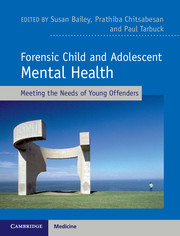Book contents
- Forensic Child and Adolescent Mental Health
- Forensic Child and Adolescent Mental Health
- Copyright page
- Dedication
- Contents
- Contributors
- Foreword
- Preface
- Prologue
- Section 1 Developmental Pathways
- Section 2 Assessment and Needs of Young Offenders
- Section 3 Serious Offences: Origins, Nature and Treatment
- Section 4 Assessment and Management
- Chapter 10 Depression, Self-Harm and Suicidal Behaviour in Young Offenders
- Chapter 11 Post-Traumatic Stress Disorder, Adjustment Disorder and Complex Trauma in Young People at Risk of Entering the Criminal Justice System
- Chapter 12 Young People with Schizophrenia in Forensic Settings
- Chapter 13 Substance Misuse in Young People with Antisocial Behaviour
- Chapter 14 Attention Deficit Hyperactivity Disorder and Antisocial Behaviour
- Chapter 15 Autism Spectrum Disorders in Young People in the Criminal Justice System
- Chapter 16 Youth Psychopathy: a Developmental Perspective
- Section 5 Therapeutic Approaches
- Section 6 Legal Frameworks, Organisations and Systems
- Epilogue
- Index
- References
Chapter 10 - Depression, Self-Harm and Suicidal Behaviour in Young Offenders
from Section 4 - Assessment and Management
Published online by Cambridge University Press: 04 May 2017
- Forensic Child and Adolescent Mental Health
- Forensic Child and Adolescent Mental Health
- Copyright page
- Dedication
- Contents
- Contributors
- Foreword
- Preface
- Prologue
- Section 1 Developmental Pathways
- Section 2 Assessment and Needs of Young Offenders
- Section 3 Serious Offences: Origins, Nature and Treatment
- Section 4 Assessment and Management
- Chapter 10 Depression, Self-Harm and Suicidal Behaviour in Young Offenders
- Chapter 11 Post-Traumatic Stress Disorder, Adjustment Disorder and Complex Trauma in Young People at Risk of Entering the Criminal Justice System
- Chapter 12 Young People with Schizophrenia in Forensic Settings
- Chapter 13 Substance Misuse in Young People with Antisocial Behaviour
- Chapter 14 Attention Deficit Hyperactivity Disorder and Antisocial Behaviour
- Chapter 15 Autism Spectrum Disorders in Young People in the Criminal Justice System
- Chapter 16 Youth Psychopathy: a Developmental Perspective
- Section 5 Therapeutic Approaches
- Section 6 Legal Frameworks, Organisations and Systems
- Epilogue
- Index
- References
- Type
- Chapter
- Information
- Forensic Child and Adolescent Mental HealthMeeting the Needs of Young Offenders, pp. 135 - 151Publisher: Cambridge University PressPrint publication year: 2017
References
- 1
- Cited by

